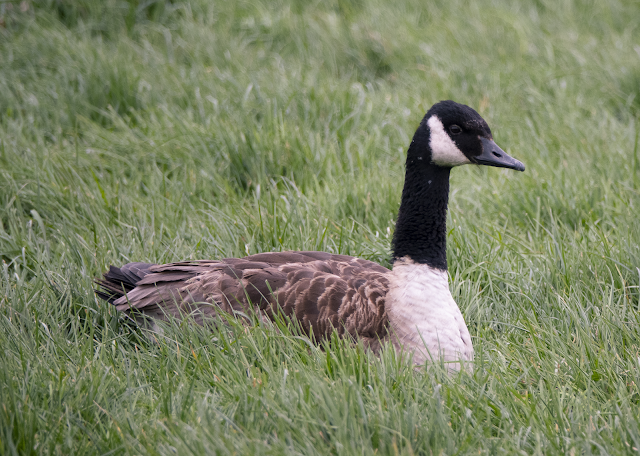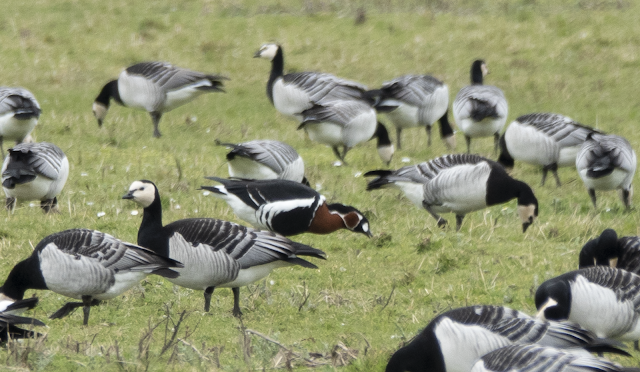Long-eared Owl
Our final port of call was at the harbour of Den Haag, where we located two Purple Sandpipers. With a little stealth, I managed to get within a couple of metres of the birds and they didn't seem especially worried about me and the camera. As we returned to the car park a Red-throated Diver was noted in the mouth of the harbour.
Purple Sandpiper
Carrion Crow
Hans dropped me off at my hotel in Rijswijk and he kindly waited for the hotel proprietor to arrive, before I bade him farewell and I checked in.
I had only pecked at food during the day, and I had skipped breakfast, so I was now quite famished and headed into the old town, where I had eaten well in 2018. I went into de Witt's and it was almost empty and on a Friday night! I sat alone and wiped all my cutlery as a precaution, after ordering the garlic mushrooms and baked salmon. This was washed down with a bottle of Affligem Tripel @ 9% abv.
On the Saturday morning, Wietze picked me up after breakfast and we drove south towards Zeeland, with numerous birding stops en route. Still in Zuid Holland, we checked out the harbour at Stellendam, where among the White Wagtails, we located a single female Pied Wagtail. A bit farther west near Ouddorp, we had a few hundred Barnacle Geese and at a nearby watch point my first Mediterranean Gulls of the trip, plus Black-tailed Godwit, Avocet, Common Redshank and Curlew.
Barnacle Geese
On the border with Zeeland, we paused on the causeway and scoped the sea, finding at least 10 Red-throated Divers, a single Great Northern Diver and two Common Scoters. Red-breasted Mergansers were common here, and I sneaked up on a splendid drake, edging closer each time it dived, until I was within a few metres of the bird.
Red-breasted Merganser
Pushing on into the next 'island' of Schouwen-Duiveland, we stopped at the sea wall at Burghsluis. Here we located a drake Velvet Scoter, which was some way out on the ebbing tide, yet clinched easily with the scope and was in the company of a single Razorbill. I hadn't even considered the latter species as one I might add on this trip, so it was two for the price of one!
We reached Vlissingen, with it's harbour and ship yard around lunch time. Here we initially had a bit of a drive round in search of our quarry, but eventually located a 2nd winter Glaucous Gull, which showed down to a few metres, catching a Common Dab while we were there. In the same vicinity we had nice views of Herring Gull and Cormorant.
Glaucous Gull
Herring Gull
Cormorant
We had fish and chips in the harbour cafe and then gradually retraced our steps. At Middelburg we located a Red-breasted Goose among the Barnacle Geese, several Greater White-fronted Geese and a male Peregrine, which took a Common Starling in flight. On the other side of the town, Wietze found a private garden, where he had been tipped off that a Little Owl is roosting and we obtained a nice record shot of the bird, sitting in its barn. On the way back north, we had nice opportunities to photograph Dark-bellied Brent Geese and Little Egret.
Red-breasted Goose
Greater White-fronted Geese
Dark-bellied Brent Goose
On the way back, crossing back into South Holland at Oostvoorne, we got distant views of a Great Bustard, although, alas the bird is from a captive bred scheme and not tickable, but was still nice to see in a wild state. Canada Goose has recently been removed from the Dutch list since the Dutch authorities have decided that there have been no genuine vagrants, and don't qualify for the official rankings. A female sitting in the grass by the farm looked suitably unimpressed by its demotion.

Canada Goose
After a long day in the field, I was ready for some nosh and had a picnic in the hotel dining room with some hummus and dips and a not for the faint-hearted bottle of 10% abv Hertog Jan. This was a Quadrupel beer and was just what was needed for the chillies and garlic flavoured hummus.
Hic!
The Sunday was a full day, with lots of driving but quality birds all the way.
We began with an adult Iceland Gull at Juliandorp in Noord Holland, which had been showing well around rooftops the previous day. Alas, it was now loafing in a field but at some distance and unlike the previous day's Glaucous Gull, provided no photo opportunities. However, it was nice to get both white-wingers on the trip.
We continued north and made a couple of stops; firstly at the harbour at Den Oever, where there were stacks of Goldeneye and Great Crested Grebes but nothing of particular note. At Kornwerdzand on the border with Friesland, the situation was rather more interesting. There was a raft of at least 1,500 Greater Scaup on the sea and by the harbour, single drake Smew and drake Goosander as well as the ever present mergansers, making it a three saw bill day.
Goosander
Greater Scaup
Smew
We made a stop at Leeuwarden looking for the resident Pied Crow, although it appeared to be having a day off, not showing around any of the houses where it normally resides.
Undeterred, we pressed on to the oddly-named Koehool, for what was bird of the weekend. The site was no more than a patchwork of fields and a couple of farmsteads. After a bit of a run around we pinned down a 2nd calendar year Sabine's Gull, which had turned up two week's earlier. The bird had remained faithful to the same patch of fields and small stream. Though we had good views, the bird was favouring a field, which bordered a private garden and made anything beyond a record shot, impossible.
Wietze decided to knock on the owner's front door, and in his best broken Frisian, asked if we might enter the garden in order to get better views. The man gave his permission and by standing in the corner of the field, the bird came pretty close. An amazing bird to see, and very unusual at this time of the year.
Sabine's Gull
Keeping one eye on the clock, we drove south east towards the border with Flevoland and connected with a Cattle Egret at Spanga, although like the Iceland Gull sat resolutely at the back of a field. We also saw a male Marsh Harrier here.
Further south near Meppel on the border of Drenthe and Overijssel we unsuccessfully searched for a White Pelican of unknown origin but were rewarded with a good views of several White Storks, who had set up home in the area.
White Stork
We finished off the day in Flevoland, unsuccessfully searching for Bewick's and Whooper Swans and in the failing light watched Black-tailed Godwits, which were coming into breeding plumage.
As we arrived at Maassluis, the news was that the government had closed all restaurants and cafes. However, Wietze knew of a Turkish kebab house that was 'off the grid.' None the less, the food was good and set me up for the evening. Wietze dropped me off at the railway station and I made the nine minute journey to Hoek van Holland for my sailing back to the UK.
Black-tailed Godwits
Many Thanks go to Wietze Janse, Hans Overduin and Menno Van Duijn


































